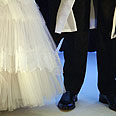


A haredi wedding begins from the moment the intended bride and groom are born. On that day they are entered into the matchmakers' registry. From that day on, the couple, parents, siblings and grandparents will be under the constant watchful eye of the matchmakers keeping tabs on the family.
A haredi wedding starts materializing once the intended bride and groom have reached a marriageable age and have gotten a glimpse into the matchmakers' lists. The embarrassing encounters usually take place in hotel lounges or public gardens. You'll recognize them by their Shabbat clothes, constant smiles and mainly the shaking of their legs. Behind them will be two sets of parents and some 20 siblings eagerly awaiting updates.
A haredi wedding is launched with the engagement ceremony in which the two sides meet for the first time while trying to find a common language, mutual acquaintances and declaring their respective fortunes. The parents will discuss the various financial aspects and unknown to the couple will settle on a wedding hall, photographer, band, catering service and flowers. In the next room, the couple will be busy telephoning all their friends to inform them of the news.
A haredi wedding is primarily a celebration for women's clothing stores. The bride, her mother and sisters must all purchase no less than 10 new outfits: For the wedding, the Seven Blessing events, the Shabbat Chatan (custom in which the groom is called up for an aliyah and recites a blessing over the Torah on the Shabbat after his wedding), which alone requires three different dresses for the three separate meals. And we haven't even mentioned jewelry, shoes and wigs. The groom will make do with one outfit and perhaps a few different ties.

A Sanz hassidic wedding (Photo: Moshe Goldstien)
A haredi wedding culminates with the chuppah, during which the bride's mother will invariably be weeping. You won't find a rabbi making jokes or explaining the significance of the ceremony. The majority of the event is extremely serious and is held in Aramaic. At the end of the chuppah, one will always find the little kids wondering where the bride and groom disappeared to and what is a cheder yichud ("Room of privacy").
A haredi wedding is, in effect, made up of two separate events, one for men and one for women, which commence straight after the chuppah. On both sides, however the menu will consist of kugel and Cholent.
A haredi wedding is all about the dancing, separate of course, which starts after the couple has left the cheder yichud and ends after the last guest has gone home. Hava Nagila will invariably be playing to hand-in-hand circle dancing.
A haredi wedding does not involve thousands of checks and huge gift packages. With so many weddings and a limited source of income guests can't afford to splurge on every single event. Still, the bride and groom will always hope that some distant rich relative or a secular cousin will leave a NIS 2,000 check (roughly $500).
A haredi wedding will always come to a close with the inevitable family photos, the subjects of which hardly keeping the eyes open out of sheer exhaustion. Ultra-Orthodox photographers deserve special citation for managing to fit in at least 45 people into one single shot – all of the same family of course.
A haredi wedding will end with a moving farewell between the parents and their kids who will be leaving home for the first time to start a family of their own. You will always find one best friend who has waited until the end of the wedding to dispense one last crucial advise to the nervous newly-weds. Oh, and you will never find a haredi couple counting checks at the end of their nuptials.
A haredi wedding will extend to an "after-party" lasting seven days and seven nights known as the Seven Blessings. Here is a chance for the families to get to know each other better, praise one another and mainly give a chance to anyone who didn't get to say a blessing during the chuppah to do so now, and invite anyone who couldn't make it to the actual wedding.
A haredi wedding is a unique and fascinating event. Dozens of weddings are held in Bnei Brak every night all within a small radius. Each wedding spawns a new Israeli family and with it a new mother-in-all, which can be the subject of several columns.
- Follow Ynetnews on Facebook















